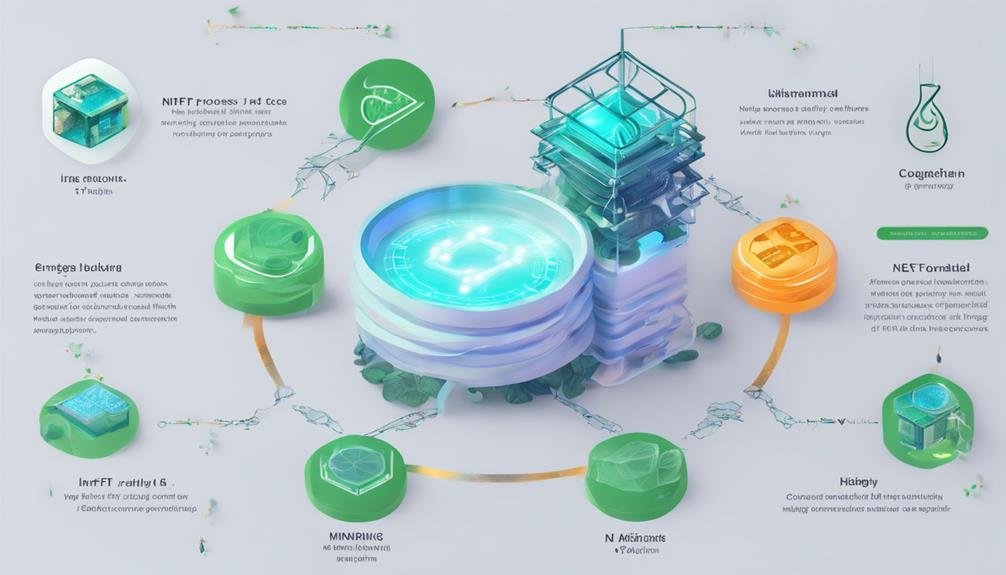Opt for eco-friendly alternatives to conventional NFTs to slash carbon emissions and champion sustainability in digital art. NFTs typically bear a hefty carbon footprint from energy-intensive operations. Platforms like Solana and Tezos are tailored to reduce energy consumption. Embracing eco-conscious NFT options, like StarkWare’s tech, can curtail carbon footprints.
These choices spotlight eco-friendly minting backed by renewable energy. Sustainable NFT platforms, with transparency in operations, prioritize greener minting processes. By choosing green NFT avenues, you pave the way for eco-conscious practices and reduce environmental impacts. Shifting to eco-friendly NFT methods can lead to a greener digital ecosystem, hinting at a more sustainable future.
Table of Contents
Brief Overview of Sustainable Alternatives To Traditional NFTs
- Reduce carbon footprint and combat climate change.
- Promote sustainable practices and responsible consumption.
- Support a greener future in NFT creation and trading.
- Contribute positively to the environment and sustainability.
- Foster a greener digital ecosystem within the crypto industry.
Environmental Impact of NFTs
Highlighting the environmental ramifications of NFTs involves shedding light on their substantial carbon footprint and energy-intensive production processes. NFT transactions contribute notably to carbon emissions due to the energy-intensive blockchain technology they rely on. The Proof of Work mechanisms in NFTs demand considerable computing power, leading to high energy consumption levels.
These energy-intensive processes consume vast amounts of electricity and leave a notable carbon footprint, indirectly impacting climate change. The energy consumption associated with NFTs’ blockchain technology can be comparable to traditional industries. The high energy requirements of creating NFTs underscore the need for more sustainable alternatives in the digital art world. Understanding the environmental impact of NFTs is essential in promoting eco-friendly practices and exploring solutions that mitigate their carbon footprint.
Energy-Efficient Blockchain Solutions

Energy-efficient blockchain solutions such as Solana and Tezos are designed to consume less energy than traditional networks. Solana’s proof-of-history mechanism and Tezos’ proof-of-stake model are examples of how these platforms prioritize efficiency. By opting for these eco-friendly alternatives, you can contribute to reducing the carbon footprint associated with NFT creation and trading.
Sustainable Blockchain Technology
Sustainable blockchain technology’s evolution towards energy-efficient solutions has dramatically reduced the environmental impact of NFT processes. Here are three key aspects to contemplate:
- Proof of Stake Mechanism: By transitioning from energy-intensive proof-of-work to proof of stake, blockchain networks decrease energy consumption, making NFT creation more sustainable.
- Adoption of Energy-Efficient Platforms: Platforms like Solana and Tezos utilize energy-efficient protocols, offering eco-friendly alternatives for NFT transactions.
- Carbon-Neutral/Negative Operations: Blockchain operations that offset carbon emissions contribute to a more sustainable NFT ecosystem by balancing out the environmental impact of these processes.
Reduced Carbon Footprint
To understand the impact of reduced carbon footprint in blockchain technology, consider the shift towards energy-efficient solutions like Solana and Tezos. These platforms consume less electricity than traditional NFT systems, making them eco-friendly alternatives that prioritize sustainability. By utilizing proof-of-stake mechanisms, these energy-efficient blockchain solutions help minimize the carbon footprint associated with NFT transactions.
Their transparent sustainability practices also showcase a commitment to reducing energy consumption and carbon emissions in the blockchain space. Embracing renewable energy sources for minting and trading digital assets further enhances their environmental friendliness. Choosing these eco-friendly alternatives benefits the planet by reducing the overall carbon impact. It sets a precedent for a more sustainable approach to blockchain technology.
Environmentally Friendly Processes
How can blockchain technologies like Solana and Tezos revolutionize NFT processes to reduce environmental impact and energy consumption? These environmentally friendly platforms offer energy-efficient solutions that significantly decrease electricity usage in minting and trading digital assets. By choosing these sustainable NFT processes, you actively contribute to lowering carbon emissions and lessening the ecological footprint associated with traditional blockchain networks.
Opting for eco-friendly blockchain technologies prioritizes energy conservation, ensuring that your NFT operations align with sustainability goals. Embracing these energy-efficient blockchains minimizes the environmental consequences of NFT production. It promotes a more environmentally conscious approach to digital asset creation and trading. Make a positive impact by selecting platforms that prioritize sustainability and consume less energy.
Sustainable NFT Platforms

Sustainable NFT platforms like Solana and Tezos employ energy-efficient blockchains, reducing their carbon footprint to a large extent. They prioritize sustainability in operations and transactions, offering eco-conscious validation methods as alternatives to traditional proof-of-work mechanisms. By utilizing renewable energy sources, these platforms aim to minimize the environmental impact of NFT creation, reflecting an industry shift towards greener minting processes.
Eco-Friendly NFT Benefits
Highlighting their dedication to environmental sustainability, platforms like Immutable X and StarkWare offer 100% carbon-neutral solutions for NFT creation. These eco-friendly NFT options help reduce the environmental impact caused by high energy consumption in traditional NFT processes. Companies like CurrencyWorks are even aiming for self-sufficiency by utilizing reclaimed energy for their NFT operations, further solidifying the eco-friendly benefits of these platforms.
Mainstream businesses and investors increasingly recognize the importance of choosing sustainable options in the NFT space, driving the adoption of such environmentally friendly solutions. Technological advancements like ZK rollup and proof-of-stake mechanisms play a vital role in enhancing the sustainability of NFT platforms, making them more ecologically friendly and aligned with eco-conscious values.
Renewable Blockchain Technology
To explore the advancements in eco-friendly blockchain technology for NFT creation, consider emerging platforms like Solana and Tezos that offer energy-efficient alternatives. These sustainable NFT platforms utilize proof-of-stake (PoS) mechanisms, significantly reducing energy consumption compared to traditional proof-of-work protocols. By prioritizing sustainability, eco-friendly blockchain platforms attract environmentally-conscious creators and investors looking to minimize their carbon footprint.
Using renewable energy sources in sustainable NFT platforms further enhances their eco-friendly credentials. This shift towards renewable blockchain technology signifies a broader industry trend towards embracing more environmentally friendly and sustainable practices. Sustainable NFT platforms like Solana and Tezos pave the way for a greener approach to NFT creation, appealing to those seeking more energy-efficient alternatives in the digital art space.
Green Minting Processes
Using energy-efficient blockchains, green minting processes on sustainable NFT platforms like Tezos and Solana significantly reduce energy consumption during NFT creation. Here are three key points to take into account:
- Sustainable NFT platforms such as Tezos and Solana use energy-efficient blockchains that notably decrease the energy required for minting digital assets.
- Tezos employs a proof-of-stake consensus mechanism, lowering energy consumption during the minting process and contributing to a more crucial approach.
- Solana’s rapid and scalable blockchain technology plays an essential role in minimizing energy usage while creating NFTs, thereby helping to reduce the carbon footprint associated with minting these digital assets. Choosing eco-friendly platforms can make a remarkable difference in environmental impact.
Digitizing Physical Assets Sustainably

Digitizing physical assets sustainably decreases traditional resources like paper, paint, or canvases and paves the way for a more environmentally conscious approach to creating digital collectibles and art. By converting physical assets into NFTs, you actively contribute to reducing the environmental impact caused by the production of physical art pieces. Sustainable NFT platforms offer eco-friendly alternatives that eliminate the need for excessive material consumption, thereby lowering material waste to a great extent.
Embracing NFTs for digital art creation streamlines the process. It aligns with a future-focused on sustainability and reduced physical waste production. Technological advancements in NFTs are essential in driving us toward a more sustainable future by minimizing material wastage and encouraging the digitalization of assets. Changing to digitizing physical assets through NFTs is vital to a more environmentally friendly and sustainable art ecosystem.
Eco-Conscious NFT Options

When contemplating eco-conscious NFT options, it’s essential to prioritize sustainability in NFT creation. Technologies like StarkWare’s, aimed at reducing the carbon footprint in Ethereum mining, offer promising solutions. Immutable X’s carbon-neutral approach caters to environmentally aware investors seeking eco-friendly NFT transactions.
Sustainable NFT Solutions
Sustainable NFT platforms prioritize sustainability by utilizing energy-efficient blockchains such as Solana and Tezos. When considering eco-conscious NFT options, here are three key aspects to focus on:
- Reducing Carbon Emissions: By choosing sustainable NFT solutions, you actively contribute to lowering carbon footprints associated with traditional NFT minting processes.
- Environmental Impact Mitigation: Sustainable NFT platforms aim to minimize the ecological impacts of NFT creation, promoting a greener approach to digital asset ownership.
- Utilizing Eco-Friendly Materials: Digitizing physical assets using sustainable materials offers an environmentally friendly way to create NFTs, aligning with eco-conscious principles.
Environmental Impact Considerations
To address environmental impact considerations in NFTs, a shift towards eco-conscious options is imperative for reducing energy consumption and carbon emissions. Opting for eco-friendly NFTs can help lower the carbon footprint equivalent to traditional industries. By choosing sustainable NFT platforms supporting renewable energy sources, you can contribute to mitigating the carbon impact of NFT creation.
Sustainable NFT solutions are emerging to address the NFT space’s energy-intensive processes and environmental concerns. Embracing eco-conscious NFT options not only aids in reducing the environmental impact but also sets a positive example for the industry. Make informed choices that prioritize sustainability and environmental responsibility in NFTs.
Reducing Carbon Footprint in NFTs

Considering the notable carbon footprint of minting NFTs on conventional blockchain platforms, exploring eco-friendly alternatives is imperative to mitigate environmental impact. To reduce the carbon footprint in NFTs, you can take the following steps:
- Opt for Proof of Stake: Choose blockchain platforms that utilize Proof of Stake consensus mechanisms instead of Proof of Work. Proof of Stake requires notably less energy consumption, lowering the carbon footprint of minting NFTs.
- Consider Layer 2 Solutions: Utilize Layer 2 scaling solutions that help reduce the energy-intensive processes involved in minting NFTs. These solutions aim to enhance blockchain efficiency, subsequently decreasing the carbon emissions related to NFT creation.
- Support Eco-Friendly NFT Marketplaces: Engage with NFT marketplaces that prioritize sustainability and eco-friendly practices in their operations. By supporting platforms that advocate for reduced carbon footprints in NFTs, you contribute to a more environmentally conscious NFT ecosystem.
Promoting Sustainability in NFT Ownership

To reduce the environmental impact of NFT ownership, exploring sustainable alternatives is essential in aligning with eco-conscious practices and minimizing carbon emissions. Choosing eco-friendly options in the NFT space is vital for addressing growing environmental concerns. Sustainable NFT platforms offer a promising solution by significantly reducing energy consumption and lessening the overall ecological footprint compared to traditional NFTs.
By embracing these eco-friendly NFT alternatives, individuals can actively contribute to initiatives that promote sustainability and combat carbon emissions. Opting for sustainable NFTs not only benefits the environment but also encourages the adoption of environmentally friendly practices within the digital art market. Investing in these eco-conscious choices aligns with the increasing consumer preference for products that prioritize sustainability. By supporting sustainable NFTs, you demonstrate a commitment to environmental conservation and pave the way for a greener future in the digital art space.
Benefits of Eco-Friendly NFTs

Eco-friendly NFTs offer significant advantages in reducing carbon emissions and promoting sustainability within the digital art market. When considering eco-friendly NFTs for your collection or investments, you contribute positively to the environment and support a more sustainable future for digital assets. Here are three key benefits of choosing eco-friendly NFTs:
- Reducing Carbon Footprint: By opting for eco-friendly NFTs, you actively mitigate the environmental impact of NFT trading and digital art ownership, helping combat climate change.
- Promoting Sustainable Practices: Sustainable NFT platforms prioritize renewable energy sources, which fosters a greener digital ecosystem and encourages responsible consumption within the crypto industry.
- Supporting a Greener Future: Investing in eco-friendly NFT options aligns with efforts to address the energy-intensive nature of blockchain technology, contributing to a more environmentally conscious approach to NFT creation and trading.
Innovations in Sustainable NFT Creation

Shifting towards a more sustainable approach in NFT creation involves exploring innovative methods and technologies that prioritize environmental consciousness. The Zer00 protocol, a popular eco-conscious process, focuses on reducing the carbon footprint associated with NFTs. Companies are also mining coins using renewable energy sources to guarantee sustainable NFT production. Innovations in cryptocurrency storage offer eco-friendly alternatives by utilizing blockchain technology to decrease energy consumption. Additionally, approximately 39% of Bitcoin mining comes from renewable energy sources, signaling a significant shift towards sustainability in the crypto space.
Platforms like Immutable X and StarkWare are driving the adoption of eco-friendly practices in NFT creation. These platforms are pioneering the use of sustainable technologies that reduce the environmental impact of NFTs. Furthermore, some companies are exploring innovative ways to repurpose materials, such as turning oil waste into usable resources for NFT production. The NFT industry strives towards a greener and more sustainable future by embracing these innovations.
Future of Eco-Friendly NFTs

Opt for renewable energy sources in creating and trading NFTs for a greener digital art market. The future of eco-friendly NFTs is promising as companies increasingly focus on sustainability. Here are three key aspects shaping the future landscape of eco-friendly NFTs:
- Shift to Sustainable NFT Platforms: NFT platforms are evolving to prioritize energy-efficient blockchain technologies to reduce the environmental impact of NFT creation and transactions.
- Adoption of Proof-of-Stake (PoS) Mechanisms: Companies are exploring alternative validation methods like proof-of-stake to make NFT operations more environmentally sustainable. PoS consumes notably less energy compared to the traditional proof-of-work model.
- Renewable Energy Integration: The future of eco-friendly NFTs involves a notable move towards using renewable energy sources to create and trade digital assets. This change will be essential in minimizing the carbon footprint associated with NFTs, contributing to a more sustainable digital art market.
Frequently Asked Questions
How Can We Make NFT Eco-Friendly?
To make NFTs eco-friendly, you can adopt green innovations and sustainable solutions. Embrace eco-conscious practices and consider carbon offsetting methods. Choose energy-efficient blockchains and platforms that prioritize sustainability to reduce the environmental impact of NFT creation.
What Is the Environmental Problem With Nfts?
Creating NFTs contributes to a high carbon footprint due to energy-intensive blockchain processes. Minting digital art can have a significant environmental impact, emitting CO2 equivalent to driving thousands of miles. Consider eco-friendly options to lessen harm.
What Is the Most Environmentally Friendly NFT Platform?
Consider options like Immutable X, StarkWare’s tech, Bubblehouse on Polygon, Solana, and Tezos for the most environmentally friendly NFT platform. These sustainable solutions offer green alternatives that are energy-efficient and driven by investor demand.
In What Ways Could Crypto Become Environmentally Friendly?
Minimize energy consumption by shifting to proof-of-stake, offset carbon emissions with carbon-neutral operations, utilize renewable energy for mining, and advocate for transparent sustainability in the blockchain. Embrace eco-friendly practices to make crypto environmentally sustainable.
Conclusion
To sum up, choosing eco-friendly alternatives in NFTs is an intelligent decision that reduces environmental impact and promotes sustainability in digital ownership. By embracing energy-efficient blockchain solutions and sustainable NFT platforms, we can pave the way for a more eco-conscious future in the digital art space. So, why settle for traditional NFTs when you can opt for a greener, more sustainable option that benefits both creators and the planet?




